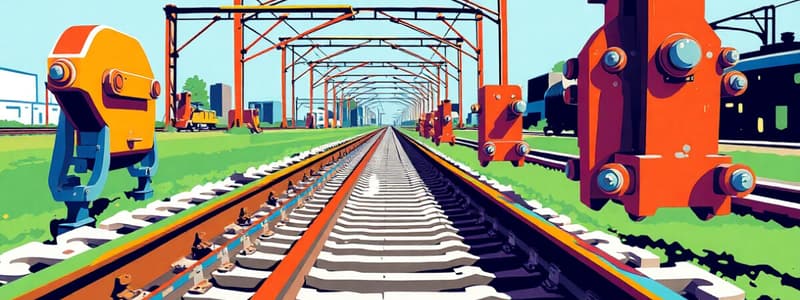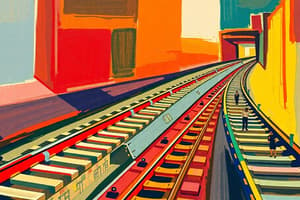Podcast
Questions and Answers
What are fish plates used for in railway tracks?
What are fish plates used for in railway tracks?
To hold two rails together in horizontal as well as vertical planes.
What is the function of bearing plates in railway tracks?
What is the function of bearing plates in railway tracks?
- To keep double headed and bull headed rails in position
- To provide drainage out of the track
- To secure and fasten rail systems
- To reduce stresses at joints and curves (correct)
What are spikes used for in railway systems?
What are spikes used for in railway systems?
To secure and fasten rail systems.
What is the primary function of track substructure?
What is the primary function of track substructure?
Which of the following is a function of subballast?
Which of the following is a function of subballast?
The subgrade is often the most stable and strongest component of track.
The subgrade is often the most stable and strongest component of track.
Subballast is typically found below the ballast and above the ______.
Subballast is typically found below the ballast and above the ______.
What are the components used to join rail to rail and rail to sleepers in a track?
What are the components used to join rail to rail and rail to sleepers in a track?
Which of the following is used to hold two rails together?
Which of the following is used to hold two rails together?
What is the function of bearing plates in tracks?
What is the function of bearing plates in tracks?
What is the primary function of the track substructure?
What is the primary function of the track substructure?
Subballast is located below the ballast and above the ______.
Subballast is located below the ballast and above the ______.
What is NOT a function of subballast?
What is NOT a function of subballast?
Why is the subgrade considered the weakest track component?
Why is the subgrade considered the weakest track component?
What is one of the structural considerations for the subgrade?
What is one of the structural considerations for the subgrade?
Flashcards are hidden until you start studying
Study Notes
Components of Tracks/Permanent Way – Fixtures & Fastening
- Fixtures and fastenings are essential for joining rail to rail and rail to sleepers, maintaining proper track alignment.
- Expansion gaps are provided between consecutive rails to accommodate thermal changes.
- Fish Plates: Devices that hold two rails together in both horizontal and vertical planes.
- Bearing Plates: Installed at joints and curves to increase bearing area, thus reducing stress on the track.
- Spikes: Fasten and secure rail systems, ensuring stability.
- Chairs: Used to maintain the position of double-headed and bull-headed rails in the permanent way.
Track Substructure
- Comprises ballast, subballast, and subgrade which support the track superstructure of rails and ties.
- Influences stability, performance of the track superstructure, and vehicle dynamics.
- Designed to distribute train loads uniformly without causing permanent deformation affecting track geometry.
Track Substructure - Subballast
- Located below the ballast and above the subgrade, can be a specified layer or formed from wear and settlement of older ballast.
- Reduces stress on the subgrade, dependent on resilient modulus and thickness.
- Stiffness of subballast controls load-spreading capabilities based on compacted density and gradation.
- Well-graded subballast achieves high relative density, whereas narrowly graded ballast demonstrates increased stiffness due to particle interlock.
Subballast Functions
- Acts as a solid, well-draining base beneath the track, separating fine subgrade soil from coarse ballast.
- Primary functions include:
- Providing effective drainage from the track.
- Reducing stress applied to the subgrade.
- Preventing intermixing between ballast and subgrade.
- Offering frost protection to subgrade in colder areas.
Track Substructure - Subgrade
- Serves as the foundational support layer, often variable and potentially weak among track components.
- Challenges in assessing subgrade conditions arise due to its inaccessibility and variable soil types over short distances.
- Understanding subgrade behavior is key for effective investigation and remediation.
Subgrade Functions
- To ensure a stable foundation, the subgrade must be structurally sound and resilient to environmental damage.
- Structural considerations include:
- Stability under self-weight to prevent deterioration via consolidation settlement or shear.
- Stability under train loads to avoid plastic strain and potential failure.
Components of Tracks/Permanent Way – Fixtures & Fastening
- Fixtures and fastenings are essential for joining rail to rail and rail to sleepers, maintaining proper track alignment.
- Expansion gaps are provided between consecutive rails to accommodate thermal changes.
- Fish Plates: Devices that hold two rails together in both horizontal and vertical planes.
- Bearing Plates: Installed at joints and curves to increase bearing area, thus reducing stress on the track.
- Spikes: Fasten and secure rail systems, ensuring stability.
- Chairs: Used to maintain the position of double-headed and bull-headed rails in the permanent way.
Track Substructure
- Comprises ballast, subballast, and subgrade which support the track superstructure of rails and ties.
- Influences stability, performance of the track superstructure, and vehicle dynamics.
- Designed to distribute train loads uniformly without causing permanent deformation affecting track geometry.
Track Substructure - Subballast
- Located below the ballast and above the subgrade, can be a specified layer or formed from wear and settlement of older ballast.
- Reduces stress on the subgrade, dependent on resilient modulus and thickness.
- Stiffness of subballast controls load-spreading capabilities based on compacted density and gradation.
- Well-graded subballast achieves high relative density, whereas narrowly graded ballast demonstrates increased stiffness due to particle interlock.
Subballast Functions
- Acts as a solid, well-draining base beneath the track, separating fine subgrade soil from coarse ballast.
- Primary functions include:
- Providing effective drainage from the track.
- Reducing stress applied to the subgrade.
- Preventing intermixing between ballast and subgrade.
- Offering frost protection to subgrade in colder areas.
Track Substructure - Subgrade
- Serves as the foundational support layer, often variable and potentially weak among track components.
- Challenges in assessing subgrade conditions arise due to its inaccessibility and variable soil types over short distances.
- Understanding subgrade behavior is key for effective investigation and remediation.
Subgrade Functions
- To ensure a stable foundation, the subgrade must be structurally sound and resilient to environmental damage.
- Structural considerations include:
- Stability under self-weight to prevent deterioration via consolidation settlement or shear.
- Stability under train loads to avoid plastic strain and potential failure.
Studying That Suits You
Use AI to generate personalized quizzes and flashcards to suit your learning preferences.




